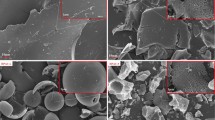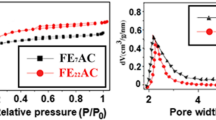Abstract
In this work, the porosity enhancement of activated carbon by hydrolyzed lignin extracted from black liquor was studied. Lignin was treated before activation and carbonization using H2SO4 hydrolysis. The effects of H3PO4 concentration (0–66 wt%) as an impregnation agent and impregnation time (0–12 h) on the activated carbon were investigated. The cadmium adsorption capacity and isotherm were also determined. Results showed that the specific surface area (SSA) of activated carbon increased with increases in H3PO4 concentration and impregnation time. The maximum specific surface area of 1,653 m2 per gram of hydrolyzed lignin was obtained using 66wt% H3PO4, impregnation time of 8 h, and carbonization at 500 °C. The adsorption isotherms of all samples were type-I, based on the International Union of Pure and Applied Chemistry. The pore size distribution of activated carbon prepared from lignin and hydrolyzed lignin without H3PO4 activation fell within the range of micropore. With 66wt% H3PO4 activation, activated carbon prepared from the lignin and the hydrolyzed lignin showed a mesoporous structure. The activated carbon prepared from hydrolyzed lignin in this study enhanced the Brunauer–Emmett–Teller-specific surface area up to 38.44% compared to that of non-hydrolyzed lignin. The maximum adsorption capacity of 9.50 and 9.69 mg of cadmium per gram of activated carbon prepared from lignin and hydrolyzed lignin, respectively, was achieved with 66wt% H3PO4 activation and 1 h of impregnations time. The adsorption isotherms of the cadmium fitted linearly with the Langmuir model. This study thus showed a promising production of highly porous activated carbon from the pulp and paper industry waste through a simple and low-cost method.
Graphical abstract










Similar content being viewed by others
Data availability
Enquiries about data availability should be directed to the authors.
References
Abdelaziz GB, El-Said EM, Bedair AG, Sharshir SW, Kabeel A, Elsaid AM (2021) Experimental study of activated carbon as a porous absorber in solar desalination with environmental, exergy, and economic analysis. Process Saf Environ Prot 147:1052–1065. https://doi.org/10.1016/j.psep.2021.01.031
Ahmad UM, Ji N, Li H, Wu Q, Song C, Liu Q, Ma D, Lu X (2021) Can lignin be transformed into agrochemicals? Recent advances in the agricultural applications of lignin. Ind Crops Prod 170:113646. https://doi.org/10.1016/j.indcrop.2021.113646
Alipoormazandarani N, Zhang Y, Fatehi P (2021) Super functional anionic hydrolysis lignin for capturing dyes. Ind Crops Prod 162:113243. https://doi.org/10.1016/j.indcrop.2021.113243
Al-Swaidan HM, Ahmad A (2011). Synthesis and characterization of activated carbon from Saudi Arabian dates tree’s fronds wastes. In: 3rd International conference on chemical, biological and environmental engineering
Brazil TR, Gonçalves M, Junior MSO, Rezende MC (2022) Sustainable process to produce activated carbon from Kraft lignin impregnated with H3PO4 using microwave pyrolysis. Biomass Bioenergy 156:106333. https://doi.org/10.1016/j.biombioe.2021.106333
Chu G, Zhao J, Huang Y, Zhou D, Liu Y, Wu M, Peng H, Zhao Q, Pan B, Steinberg CEW (2018) Phosphoric acid pretreatment enhances the specific surface areas of biochars by generation of micropores. Environ Pollut 240:1–9. https://doi.org/10.1016/j.envpol.2018.04.003
Dornelles LB, Filho RM, Mariano AP (2021) Organosolv fractionation of eucalyptus: economics of cellulosic ethanol and chemicals versus lignin valorization to phenols and polyols. Ind Crops Prod 173:114097. https://doi.org/10.1016/j.indcrop.2021.114097
El-Said EM, Dahab MA, Omara MA, Abdelaziz GB (2022) Humidification-dehumidification solar desalination system using porous activated carbon tubes as a humidifier. Renew Energy 187:657–670. https://doi.org/10.1016/j.renene.2022.01.023
Fu K, Yue Q, Gao B, Sun Y, Zhu L (2013) Preparation, characterization and application of lignin-based activated carbon from black liquor lignin by steam activation. Chem Eng J 228:1074–1082. https://doi.org/10.1016/j.cej.2013.05.028
Gao Y, Yue Q, Gao B, Sun Y, Wang W, Li Q, Wang Y (2013) Preparation of high surface area-activated carbon from lignin of papermaking black liquor by KOH activation for Ni(II) adsorption. Chem Eng J 217:345–353. https://doi.org/10.1016/j.cej.2012.09.038
Han Q, Wang J, Goodman BA, Xie J, Liu Z (2020) High adsorption of methylene blue by activated carbon prepared from phosphoric acid treated eucalyptus residue. Powder Technol 366:239–248. https://doi.org/10.1016/j.powtec.2020.02.013
Jutakridsada P, Prajaksud C, Kuboonya-Aruk L, Theerakulpisut S, Kamwilaisak K (2016) Adsorption characteristics of activated carbon prepared from spent ground coffee [Review]. Clean Technol Environ Policy 18(3):639–645. https://doi.org/10.1007/s10098-015-1083-x
Kavand M, Eslami P, Razeh L (2020) The adsorption of cadmium and lead ions from the synthesis wastewater with the activated carbon: optimization of the single and binary systems. J Water Process Eng 34:101151. https://doi.org/10.1016/j.jwpe.2020.101151
Kim D, Cheon J, Kim J, Hwang D, Hong I, Kwon OH, Park WH, Cho D (2017) Extraction and characterization of lignin from black liquor and preparation of biomass-based activated carbon there-from. Carbon Lett 22:81–88. https://doi.org/10.5714/CL.2017.22.081
Lewoyehu M (2021) Comprehensive review on synthesis and application of activated carbon from agricultural residues for the remediation of venomous pollutants in wastewater. J Anal Appl Pyrol 159:105279. https://doi.org/10.1016/j.jaap.2021.105279
Li Y, Du Q, Liu T, Peng X, Wang J, Sun J, Wang Y, Wu S, Wang Z, Xia Y (2013) Comparative study of methylene blue dye adsorption onto activated carbon, graphene oxide, and carbon nanotubes. Chem Eng Res Des 91(2):361–368. https://doi.org/10.1016/j.cherd.2012.07.007
Liao Z, Zhu Y-H, Sun G-T, Qiu L, Zhu M-Q (2022) Micromorphology control of the lignin-based activated carbon and the study on the pyrolysis and adsorption kinetics. Ind Crops Prod 175:114266. https://doi.org/10.1016/j.indcrop.2021.114266
Ma HT, Ho VTT, Pham NB, Bach LG, Phan DT (2018) The comparison of surface modification methods of the heavy metals adsorption of activated carbon from rice husk. Appl Mech Mater 876:91–96. https://doi.org/10.4028/www.scientific.net/AMM.876.91
Mussatto SI, Fernandes M, Rocha GJM, Órfão JJM, Teixeira JA, Roberto IC (2010) Production, characterization and application of activated carbon from brewer’s spent grain lignin. Biores Technol 101(7):2450–2457. https://doi.org/10.1016/j.biortech.2009.11.025
Ngernyen Y, Kamwilaisak K (2013) Activated carbon from Thailand’s biomass: a review literature. Eng Appl Sci Res 40(2):267–283
Paluri P, Durbha KS (2021) Equilibrium, kinetic, and thermodynamic study for the adsorption of methylene blue onto activated carbons prepared from the banana root through chemical activation with phosphoric acid. Biomass Convers Biorefinery. https://doi.org/10.1007/s13399-021-01883-2
Ping G, Miao L, Awati A, Qian X, Shi T, Lv Y, Liu Y, Gan L, Liu M, Zhu D (2021) Porous carbon globules with moss-like surfaces from semi-biomass interpenetrating polymer network for efficient charge storage. Chin Chem Lett. https://doi.org/10.1016/j.cclet.2021.04.055
Ponomarev N, Sillanpää M (2019) Combined chemical-templated activation of hydrolytic lignin for producing porous carbon. Ind Crops Prod 135:30–38. https://doi.org/10.1016/j.indcrop.2019.03.050
Prado R, Erdocia X, Labidi J (2013) Effect of the photocatalytic activity of TiO2 on lignin depolymerization. Chemosphere 91(9):1355–1361. https://doi.org/10.1016/j.chemosphere.2013.02.008
Saleem J, Shahid UB, Hijab M, Mackey H, McKay G (2019) Production and applications of activated carbons as adsorbents from olive stones. Biomass Convers Biorefinery 9(4):775–802. https://doi.org/10.1007/s13399-019-00473-7
Sathawong S, Sridach W, Techato K-A (2018) Lignin: Isolation and preparing the lignin based hydrogel. J Environ Chem Eng. https://doi.org/10.1016/j.jece.2018.05.008
Sinha P, Datar A, Jeong C, Deng X, Chung YG, Lin L-C (2019) Surface area determination of porous materials using the Brunauer–Emmett–Teller (BET) method: limitations and improvements. J Phys Chem C 123(33):20195–20209. https://doi.org/10.1021/acs.jpcc.9b02116
Suhas CPJM, Ribeiro Carrott MML (2007) Lignin—from natural adsorbent to activated carbon: a review. Biores Technol 98(12):2301–2312. https://doi.org/10.1016/j.biortech.2006.08.008
Sun Y, Yue Q, Gao B, Huang L, Xu X, Li Q (2012) Comparative study on characterization and adsorption properties of activated carbons with H3PO4 and H4P2O7 activation employing Cyperus alternifolius as precursor. Chem Eng J 181–182:790–797. https://doi.org/10.1016/j.cej.2011.11.098
Tang D, Luo Y, Lei W, Xiang Q, Ren W, Song W, Chen K, Sun J (2018) Hierarchical porous carbon materials derived from waste lentinus edodes by a hybrid hydrothermal and molten salt process for supercapacitor applications. Appl Surf Sci 462:862–871. https://doi.org/10.1016/j.apsusc.2018.08.153
Wang L, Wang X, Zou B, Ma X, Qu Y, Rong C, Li Y, Su Y, Wang Z (2011) Preparation of carbon black from rice husk by hydrolysis, carbonization and pyrolysis. Biores Technol 102(17):8220–8224. https://doi.org/10.1016/j.biortech.2011.05.079
Wang W, Liu Y, Liu X, Deng B, Lu S, Zhang Y, Bi B, Ren Z (2018) Equilibrium adsorption study of the adsorptive removal of Cd2+ and Cr6+ using activated carbon. Environ Sci Pollut Res 25(25):25538–25550. https://doi.org/10.1007/s11356-018-2635-5
Xi Y, Wang Y, Yang D, Zhang Z, Liu W, Li Q, Qiu X (2019) K2CO3 activation enhancing the graphitization of porous lignin carbon derived from enzymatic hydrolysis lignin for high performance lithium-ion storage. J Alloys Compd 785:706–714. https://doi.org/10.1016/j.jallcom.2019.01.039
Xu J, Zhou X, Chen M, Shi S, Cao Y (2018) Preparing hierarchical porous carbon aerogels based on enzymatic hydrolysis lignin through ambient drying for supercapacitor electrodes. Microporous Mesoporous Mater 265:258–265. https://doi.org/10.1016/j.micromeso.2018.02.024
Yakout SM, Sharaf El-Deen G (2016) Characterization of activated carbon prepared by phosphoric acid activation of olive stones. Arab J Chem 9:S1155–S1162. https://doi.org/10.1016/j.arabjc.2011.12.002
Zhang H, Wu S, Xie J (2017) Evaluation of the effects of isolated lignin on enzymatic hydrolysis of cellulose. Enzyme Microb Technol 101:44–50. https://doi.org/10.1016/j.enzmictec.2017.03.001
Zhao B, Borghei M, Zou T, Wang L, Johansson L-S, Majoinen J, Sipponen MH, Österberg M, Mattos BD, Rojas OJ (2021) Lignin-based porous supraparticles for carbon capture. ACS Nano 15(4):6774–6786. https://doi.org/10.1021/acsnano.0c10307
Zhong Z-Y, Yang Q, Li X-M, Luo K, Liu Y, Zeng G-M (2012) Preparation of peanut hull-based activated carbon by microwave-induced phosphoric acid activation and its application in Remazol Brilliant Blue R adsorption. Ind Crops Prod 37(1):178–185. https://doi.org/10.1016/j.indcrop.2011.12.015
Acknowledgements
The authors would like to acknowledge the “Support by Research and Graduate Studies” Khon Kaen University. This work was supported by the National Science, Research and Innovation Fund (NSRF) via the Program Management Unit for Human Resources & Institutional Development, Research and Innovation [Grant number B05F630052] and Research and Graduate Studies Khon Kaen University, Thailand. The kind suggestion from Mr. Harit Phowatthanasathian is gratefully acknowledged here.
Funding
The authors have not disclosed any funding.
Author information
Authors and Affiliations
Corresponding author
Ethics declarations
Competing interests
The authors have not disclosed any competing interests.
Additional information
Publisher's Note
Springer Nature remains neutral with regard to jurisdictional claims in published maps and institutional affiliations.
Supplementary Information
Below is the link to the electronic supplementary material.
Rights and permissions
About this article
Cite this article
Kamwilaisak, K., Siripanee, S., Jutakridsada, P. et al. Porosity enhancement of activated carbon by hydrolyzed lignin from black liquor. Clean Techn Environ Policy 24, 2517–2530 (2022). https://doi.org/10.1007/s10098-022-02331-z
Received:
Accepted:
Published:
Issue Date:
DOI: https://doi.org/10.1007/s10098-022-02331-z




